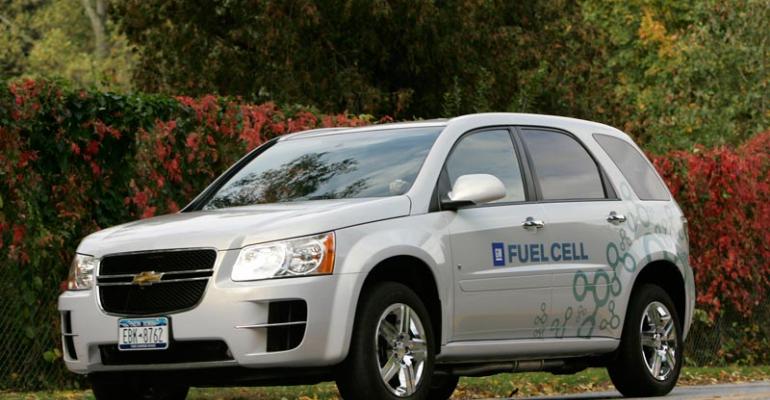WASHINGTON – The U.S. Department of Energy says it’s not giving up on hydrogen-fuel-cell electric vehicles, with plans to continue research and development and award funding to the oft-maligned alternative-propulsion strategy.
“Fuel cells are still an emerging industry,” says Sunita Satyapal, director-Hydrogen and Fuel Cells Program & Fuel Cell Technologies Office at the DOE.
“We all recognize both from the government side and the industry side that sustained commitment and investment is essential,” she says at the recent Society of Automotive Engineers Government/Industry meeting here.
Satyapal’s session on new fuel-cell developments marks the first time in a number of years the topic has made the agenda at the annual conference, underscoring its resurgence among automobile manufacturers and policy makers.
Hydrogen FCEVs once boasted close attention, with auto makers such as General Motors, Toyota and Chrysler planning to deliver the first commercial units to U.S. consumers by 2010.
So far, only Honda has come through with its FCX Clarity sedan. In its four years on the market, the latest-generation model has sold only 40 units, according to WardsAuto data, through a $600-a-month lease program in California.
Honda executives, who targeted about 200 Clarity deliveries over a 3-year period, blame the sales flop on the lack of fueling infrastructure. There are fewer than 25 hydrogen filling stations in California, and nationally about 50 public, private and research stations either on line or under development.
Cost also has been a major market impediment for FCEVs. The vehicle’s fuel-cell stack that converts hydrogen to electricity contains expensive rare metals, such as platinum.
Bob Lutz, former GM vice chairman and product development chief, claims the test fleet of 100 Chevrolet Equinox FCEVs the auto maker put on the road in 2008 cost upwards of $100,000 apiece to build because of the pricey fuel-stack materials.
There’s also a safety issue. The hydrogen must be stored aboard the vehicle at extremely high pressures that puts their crashworthiness in question.
Auto makers, nevertheless, remain captivated by the potential of FCEVs, which as zero-emissions vehicles would help them meet their federal emissions requirements and rising fleet fuel-economy standards that could peak at 54.5 mpg (4.3 L/100 km) by 2025.
Daimler, Ford and Nissan last month announced plans to deliver an affordable FCEV to market within five years. Toyota and BMW recently launched a joint effort to mass-market FCEVs by 2017 and Hyundai plans an FCEV that it promises to sell for about $46,000 per unit.
GM, long the industry leader in the technology and noted for building the first FCEV in 1968, continues to invest in the technology, but its new leadership appears less aggressive over commercialization.
Chairman and CEO Dan Akerson told journalists earlier this month the auto maker would wait until costs came down further and the refueling infrastructure saw more growth before bringing salable units to market.
GM engineers believe commercialization could occur in the 2015-2016 timeframe, although the cars would not be profitable for the first two or three generations. The auto maker recently moved its New York-based FCEV unit to its powertrain-development headquarters in Pontiac, MI.
The DOE currently is focusing on two principal R&D areas: hydrogen production, delivery and storage; and fuel cells. Between those two areas, the agency conducts activities such as manufacturing R&D and safety, codes and standards research.
The DOE funds nearly 300 FCEV projects at companies, national laboratories and universities, Satyapal says, with about $1 billion spent in the past five years. The work has reduced the cost of fuel cells by 80%, while platinum use in the fuel-cell stack has declined fivefold in the past few years.
The agency recently conducted the world’s largest FCEV demonstration project. Funded 50/50 by government and industry, the project put 180 FCEVs on the road, logging more than 3.5 million miles (5.6 million km). Data from the activity has been posted on the DOE website, including key metrics on efficiency, range and durability.
DOE activity also has deployed 1,200 hydrogen fuel cells to industry, mostly in the form of forklifts and stationary backup-power units for cellular-telephone towers. Funding of $42 million came from the $831 billion American Recovery and Reinvestment Act of 2009.
More than 5,000 orders have been placed for the equipment by corporations such as AT&T, FedEx, Coca-Cola and Sprint.
“This is a good example where the government comes in as a catalyst, where risk is high and investment is high and there is economic benefit,” Satyapal says. “Some of these early market applications can help develop the emerging supply base before widespread (FCEVs) takeover.”
The U.S. leads all nations in FCEV development, with 40% of the world’s patents in the field filed between 2002 and 2011, she says, noting the USDOE plans to focus more in the coming years on refueling infrastructure.
Two leading options for distribution would be initially using natural gas at a central point to produce the hydrogen and then shipping it to filling stations, or producing the hydrogen at the filling station on a smaller scale.
The DOE’s long-term goal would be hydrogen available at the pump for a gallon-of-gasoline (3.8 L) equivalent of $2-$4.
“We continue to fund R&D to drive the costs down and track progress, using different ways to produce the hydrogen,” Satyapal says.
GM previously has said it reduced the number of parts in its next-generation FCEV propulsion system by two times compared with that of the Project Driveway Equinox vehicles, while tripling the unit’s durability and cutting platinum use in the fuel stack by four times.
Net power of GM’s FCEV remains 124 kW (166 hp), but the auto maker says cost of composite hydrogen-fuel tanks remains high because they rely on carbon-fiber construction to strike a balance between light weight and durability.





